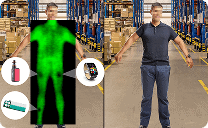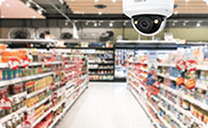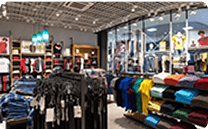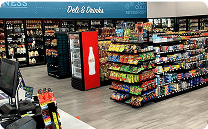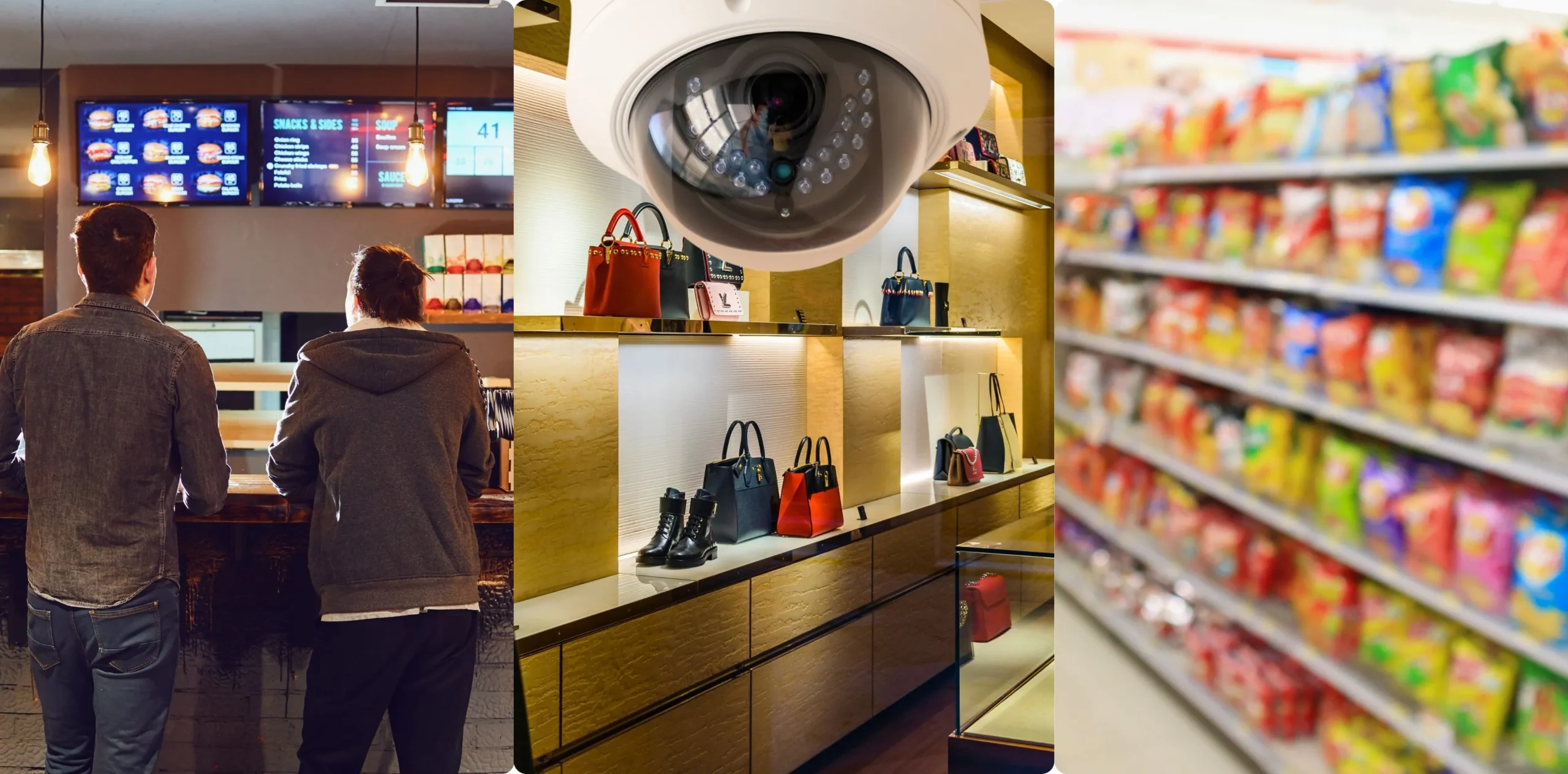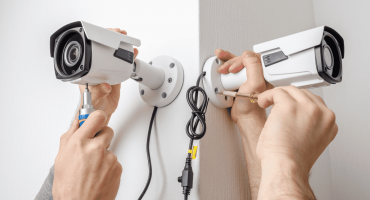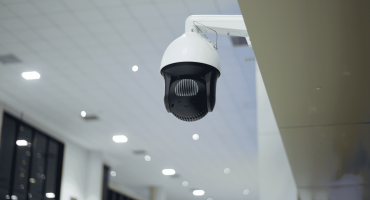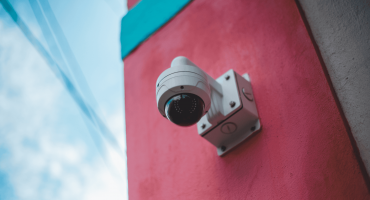In This article
Video surveillance has come a long way since the early days of closed-circuit television (CCTV). What once required extensive data infrastructure and around-the-clock monitoring (generally by on-site personnel) can now be accomplished quickly and affordably.
What’s changed? Things are much simpler thanks to today’s intelligent video surveillance solutions.
More specifically, internet-connected cameras and remote monitoring capabilities make streaming 24/7 video data to mobile devices easy. Businesses can now outsource this technology to third-party providers, meaning the onus is no longer on owners to build and manage their surveillance systems in-house. Finally, intelligent video capabilities like computer vision and data analytics have automated many tasks — paving the way for new surveillance applications altogether.

As a result, surveillance is no longer restricted to enterprise and government settings. Most households now rely on doorbell cams to deter porch pirates, and live-streaming baby monitors have become the norm. Likewise, intelligent video surveillance is now an essential technology for brick-and-mortar businesses — including quick-service restaurants, retail stores, gas stations, and more.
In this guide to understanding video surveillance trends, technology, and more, we look at the unexpected ways that businesses are using video surveillance to drive bottom-line growth and the cutting-edge technologies guiding this transformation.
Keep reading for the deep dive or navigate to the topic of your choosing through the nav on the left.
1. Artificial intelligence (AI) and computer vision
Video surveillance is only useful when you have eyes on the footage 24/7. That leaves businesses with two choices: either hire dedicated staff to monitor the live video feeds or find creative ways to computerize these tasks.
Enter AI and computer vision.
Today’s businesses are making the most out of their surveillance systems by offloading video monitoring to intelligent systems that use computer vision to process real-time data. As defined by IBM, “Computer vision is a field of artificial intelligence (AI) that enables computers and systems to derive meaningful information from digital images, videos, and other visual inputs — and take actions or make recommendations based on that information.”

Examples of computer vision in surveillance applications include:
- Motion detection: Tracking unauthorized behavior, after-hours entry, or product theft by detecting moving objects within a static sequence.
- Object detection: Using computer vision to identify things like cars in a drive-thru, empty plates on a table, etc.
- Queue management: Counting how many people enter a store or line up at a restaurant counter.
These capabilities make it easy for managers of multi-location businesses to keep an eye on their locations while they’re on the go. Imagine a door is left unlocked after hours at a convenience store and an unwanted visitor enters the location. An intelligent video platform with computer vision could be programmed to send push notifications to all users — ensuring that further business risks don’t occur.
2. Machine learning and video analytics
If computer vision gives surveillance systems the ability to see, the next step is enabling them to think. This is where machine learning and analytics come into play.
Metrics on the speed of service, the number of people in a line, average wait time, and total customer count can all be tracked using advanced video analytics. From there, businesses can use this data to drive operational improvements.
Sophisticated surveillance solutions are also being used to provide visibility into disparate areas of a multi-step process (such as queueing, order-taking, paying, and pickup) and gather insight into the end-to-end process.

Some of the ways analytics can be applied to business surveillance include:
- Order accuracy: Match drive-thru orders with the right vehicles using a multi-lane drive-thru surveillance solution designed to confirm order accuracy.
- Location-based benchmarking: Compare business performance across different locations and make data-driven decisions based on the findings.
- Speed-of-service benchmarking: Use historic trends to define key performance indicators (KPIs) related to service efficiency and set up real-time alerts when these aren’t met.
- Employee performance incentives: Set goals based on current metrics about employee productivity and use video analytics to track performance improvements and drive retention.
- Suspicious activity detection: Flag suspicious activity, like cash refunds that occur after hours, and use manual audits to automate fraud detection by scoring events based on fraud probability.
In a nutshell: Computer vision is making surveillance more powerful by capturing all the data. And video analytics solutions are transforming this data into actionable insight that businesses can benchmark and track.
3. Ethical AI through human auditing
As we all know too well, AI models can hallucinate, perpetuate biases, and trigger alerts for no reason at all. This is why ethical AI has become such a hot topic.
When it comes to surveillance, AI-based capabilities are great for automating loss prevention and driving operational improvements, but these models shouldn’t serve as the be-all and end-all. Using a human-in-the-loop approach helps prevent false alarms while providing the direct feedback needed for continuous improvements.

The demand for human expertise in surveillance systems will grow in 2024. People have become wary of AI-only solutions, and a combined approach that maximizes the strengths of both AI and human intelligence will be the gold standard for businesses going forward.
Keeping human intelligence in today’s smart surveillance systems also helps train surveillance analytics for the future. Fraudulent practices evolve daily, which means that AI models need ongoing feedback to stay ahead of major business risks.
meaning AI models need ongoing feedback to avoid
4. Integration of cloud-based solutions
Intelligent video systems are transforming surveillance. But all this computing power requires substantial infrastructure. Likewise, businesses looking to store 24/7 video footage often run into limitations.
Imagine an entire room filled with blinking lights and whirring fans. That can be the reality of storing such robust data when using an on-premises method.
Thankfully, solutions like DTiQ’s Cloud Archive, eliminate the need to equip and maintain on-site server rooms, while also making it easy to scale. Businesses relying on cloud-based surveillance gain the agility to adjust storage needs as their requirements grow — combined with the flexibility of accessing footage whenever and wherever.
“The Cloud Archive system helps us easily save content involving slip and falls or theft. The feature has been very handy for us.”
—Amish Patel
Owner of 27 Dunkin’ locations
But is it really necessary to keep all this footage on hand? Absolutely. Fraudulent slip-and-fall claims, robberies, and more can be settled efficiently with an archive of surveillance data that can be accessed on demand. And with traditional surveillance systems that purge the data every 90 days, businesses have no way of proving what actually happened after the fact.
Cloud-based surveillance is a clear winner for businesses looking to ensure that their footage is readily available, without hosting it all on site.
5. Video sharing and compression advancements
Video sharing is a crucial capability, and one that many surveillance providers have neglected. Proprietary media formats often make it difficult for business operators to share footage with external stakeholders like law enforcement; and multi-camera systems require users to wade through hours of footage before finding what they need.
Another technology advancement that’s made surveillance technology more attractive to small businesses is improvements in video compression. It used to be that the bandwidth required to support a single 24/7 live feed was more than most restaurants or retail stores could handle.
This is no longer the case, but when you add additional cameras to the entrance, drive-thru, or stockroom without configuring them appropriately, surveillance systems can quickly turn into bandwidth hogs. What’s more, many systems default to high-definition, prioritizing video quality over business uptime.
To this end, we’d recommend asking the following when evaluating surveillance vendors:
- Video format: Is footage saved in a common format like MP4, or does the system require proprietary software to access the content?
- Bandwidth requirements: Will deploying the system eat up all the bandwidth needed for basic business operations (e.g., the point-of-sale system) or are there safeguards in place to ensure bandwidth efficiencies?
- Accessibility: How easy is it to share the footage with law enforcement or other third parties that aren’t users within the system?
6. Edge computing and hybrid data processing
Video surveillance systems often serve two functions:
- Real-time insight into business operations
- Historical data about past events
Cloud-based storage enables the latter, as discussed above. When it comes to real-time insight, though, edge computing enters the picture.
Edge computing refers to processing data at the edge of the network, closer to where it’s generated. This eliminates the need to transmit all video data to the cloud for analysis, resulting in several key benefits:
- Reduced latency. By processing data locally, edge computing minimizes the time it takes for video footage to be analyzed. This translates to faster response times for security threats or operational issues. Imagine a situation where someone enters a location outside of operating hours. With edge computing, object detection software can trigger an immediate alert, ensuring the issue is addressed quickly.
- Improved bandwidth efficiency. Traditionally, surveillance systems transmit raw video footage to a central server or cloud for processing. This can consume significant bandwidth, especially with high-resolution cameras. Edge computing reduces this burden by processing data locally and only transmitting relevant alerts or insights to the cloud. This frees up valuable bandwidth for other critical business operations.
- Privacy advantages. In some cases, concerns may exist regarding the transmission of sensitive video data to the cloud. Edge computing allows for local processing of video data, potentially addressing privacy concerns for businesses operating in industries with stricter data regulations.
To take advantage of edge computing, it’s important to evaluate surveillance platforms in terms of their computing footprint and flexibility. You’ll want to ensure that the service you choose has high-bandwidth locations close to your storefront where the data can be processed. Alternatively, if internet connectivity is lacking in your location, you’ll want to find a solution that can be processed using a local GPU server.
7. Enhanced cybersecurity measures
With so much surveillance data being processed and stored in the cloud, cybersecurity has become a major concern. Just as you wouldn’t leave your in-store footage on a flash drive hanging in the break room, you’ll also want to ensure your surveillance partner prioritizes secure practices.
Regional compliance standards and regulations will influence what cybersecurity measures are required for your business. But it often comes down to keeping your customers’ personal identifiable information (PII) safe.
To this end, businesses deploying video surveillance solutions should consider what data is shared where. It’s also a good idea to validate that your video surveillance partner understands the laws and regulations in your specific region, as well as your business model.
Transparency to end users is also key. Any company using video surveillance should be frank with customers. All you need for this is appropriate signage indicating that cameras are in use.
8. Emerging surveillance applications
While we typically think of surveillance in terms of loss prevention and security, new applications pop up each day. Employee onboarding and training, operational efficiency improvements, and performance recognition programs are all being driven by intelligent video-based surveillance solutions.
In 2024, surveillance is expanding beyond the original aim of catching people red-handed. But to take advantage of these supplementary benefits, businesses must partner with surveillance service providers that are adapting their platform to other use cases.
Here are some of the surveillance applications that businesses use today:
- Loss prevention: Tracking theft and other preventable losses and then using AI-powered analytics to identify patterns associated with this fraudulent activity to implement preventative measures.
- Revenue optimization: Assessing factors that impact revenue streams, such as drive-thru wait times or order accuracy, and making improvements based on the data.
- Operating efficiencies: Gaining full visibility into inventory management and food spoilage as a way to track inventory levels, monitor food storage, and minimize waste.
- Employee empowerment: Using video-based data to recognize top performers, provide constructive feedback to teams, and develop training programs for new hires.
As more businesses implement intelligent surveillance solutions, this list will only expand. Likewise, different use cases will emerge for individual industries, which brings us to the next trend.
9.Industry-specific surveillance solutions
Different businesses have different business challenges, revenue opportunities, and operation procedures. As such, today’s surveillance platforms are niching down on specific industries to deliver more value than a one-size-fits-all solution can provide.
Businesses can and should demand this level of specificity from their surveillance partners, which requires three things:
- Industry-specific solutions. Make sure that the service you choose works for your business by looking for business intelligence solutions tailored to your unique industry. DTiQ, for example, specializes in quick-service restaurants, convenience stores, and retail stores — offering unique capabilities for each.
- Domain expertise. Surveillance systems are only as knowledgeable as the people operating them. Find out if your surveillance partner is staffed by call center employees or former business operators in your industry.
- White glove approach. Surveillance technology is great. But without the ongoing partnership required to make the most out of your video monitoring solution, it’s impossible to get the full benefit.
10. White glove approach
Surveillance technology has come a long way, evolving from clunky CCTV systems to intelligent video solutions with real-time insights and advanced analytics. While these advancements offer significant benefits, businesses are still challenged to maximize the value they get from their surveillance systems.
This is why the concept of a “white-glove” approach to surveillance technology has been picking up traction. It goes beyond simply offering the technology itself and focuses on providing a comprehensive, high-touch service experience.
Today’s businesses are gravitating towards more hands-on providers due to the need for:
- Ongoing support. The best surveillance solutions aren’t static. A white-glove provider offers ongoing support to ensure your system remains optimized for your needs. This may include regular consultations, data analysis assistance, and system maintenance.
- Seamless integration. Dedicated customer success resources help ensure a smooth integration of the surveillance system into your existing infrastructure. This includes not only technical aspects but also training your staff on how to best leverage the system’s capabilities.
- Proactive management. In 2024, surveillance should go beyond reactive responses. This requires finding a provider that proactively monitors your system, identifies potential issues, and suggests improvements based on data insights.
Conclusion
Video surveillance has undergone a remarkable transformation, shedding its clunky past to become a powerful tool driven by AI, cloud computing, and advanced analytics. But maximizing the value of a surveillance system requires more than just tech.
It’s important to find a surveillance platform that’s taking advantage of industry advancements and adapting to your unique business model. This requires both the technological prowess to frequently release updates and the human-driven approach necessary to truly partner with customers.
Imagine a future where surveillance seamlessly integrates with your existing infrastructure, providing actionable insights that drive operational efficiency, improve revenue streams, and drive employee retention. This future is closer than you think, and it’s being shaped by businesses that embrace a partnership-driven approach to video surveillance.
If you’re looking for a surveillance partner that can evolve alongside your business, while offering the expertise required to make sense of all the data, look no further than DTiQ.
